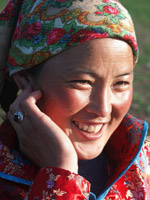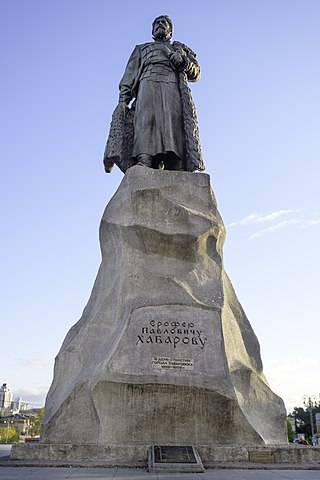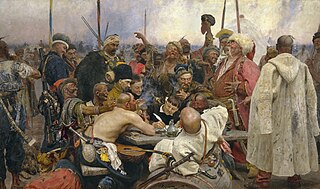The Eight Banners were administrative and military divisions under the Later Jin and Qing dynasties of China into which all Manchu households were placed. In war, the Eight Banners functioned as armies, but the banner system was also the basic organizational framework of all of Manchu society. Created in the early 17th century by Nurhaci, the banner armies played an instrumental role in his unification of the fragmented Jurchen people and in the Qing dynasty's conquest of the Ming dynasty.

The Daur people, Dagur, Daghur or Dahur are a Mongolic people originally native to Dauria and now predominantly located in Northeast China. The Daur form one of the 56 ethnic groups officially recognised in the People's Republic of China. They numbered 131,992 according to the latest census (2010) and most of them live in Morin Dawa Daur Autonomous Banner in Hulun Buir, Inner Mongolia and Meilisi Daur District in Qiqihar, Heilongjiang of China. There are also some near Tacheng in Xinjiang.

The Niohuru were a prominent Manchu clan during the Qing dynasty. The clan had inhabited the Changbai Mountains since as early as the Liao dynasty. The clan was well known during the Qing dynasty for producing a variety of consorts of all ranks for emperors, several of whom went on to become mothers to reigning emperors. Prominent people who belonged or trace heritage to the Niohuru clan including famed Manchu warrior Eidu, his son the high official Ebilun, the Empress Dowager Ci'an, the infamous corrupt official Heshen, the contemporary concert pianist Lang Lang and Lang Tsuyun, Taiwanese TV, movie and stage actress, singer and producer.

Yerofey Pavlovich Khabarov-Svyatitsky, was a Russian entrepreneur and adventurer, best known for his exploring the Amur river region and his attempts to colonize the area for Russia. For background, see Russian–Manchu border conflicts.

Empress Xiaozhaoren, of the Manchu Bordered Yellow Banner Niohuru clan, was a posthumous name bestowed to the wife and second empress consort of Xuanye, the Kangxi Emperor. She was empress consort of China during the Qing dynasty from 1677 until her death in 1678.

Albazino is a village (selo) in Skovorodinsky District of Amur Oblast, Russia, noted as the site of Albazin (Албазин), the first Russian settlement on the Amur River.

The Empress of the Nara clan of the Manchu Bordered Blue Banner, was the second wife of the Qianlong Emperor. She was the empress consort of the Qing dynasty from 1750 until her death in 1766. Informally known as the Step-Empress, she is one of the most controversial female figures in Chinese history.

The Sino-Russian border conflicts (1652–1689) were a series of intermittent skirmishes between the Qing dynasty of China, with assistance from the Joseon dynasty of Korea, and the Tsardom of Russia by the Cossacks in which the latter tried and failed to gain the land north of the Amur River with disputes over the Amur region. The hostilities culminated in the Qing siege of the Cossack fort of Albazin in 1686 and resulted in the Treaty of Nerchinsk in 1689 which gave the land to China.
The Qing dynasty (1644–1912) of China developed a complicated peerage system for royal and noble ranks.

The Albazinians are one of the few Chinese ethnic groups of Russian descent. There are approximately 250 Albazinians in China who are descendants of about fifty Russian Cossacks from Albazin on the Amur River that were resettled by the Kangxi Emperor in the northeastern periphery of Beijing in 1685. Albazin was a Russian fort on the Amur River, founded by Yerofey Khabarov in 1651. It was stormed by Qing troops in 1685. The majority of its inhabitants agreed to evacuate their families and property to Nerchinsk, whereas several young Cossacks resolved to join the Manchu army and to relocate to Beijing. See Sino-Russian border conflicts.
The Imperial Household Department was an institution of the Qing dynasty of China. Its primary purpose was to manage the internal affairs of the Qing imperial family and the activities of the inner palace, but it also played an important role in Qing relations with Tibet and Mongolia, engaged in trading activities, managed textile factories in the Jiangnan region, and even published books.

Booi Aha is a Manchu word literally meaning "household person", referring to hereditarily servile people in the Eight Banner system in 17th-century Qing China. It is often directly translated as "bondservant", although sometimes also simply rendered as the common word, slave, or more specifically within Chinese social and political context as nucai.
Manchu names are the names of the Manchu people in their own language. In addition to such names, most modern Manchus live in China and possess Chinese names.
Imperial Noble Consort Zhemin, of the Manchu Plain Yellow Banner Fuca clan, was a consort of the Qianlong Emperor.
Cigu Niru was a type of military unit of Qing China. It was one of the Nirus of the Qing army. The Cigu Niru consisted of ethnic Han soldiers who joined the Qing army in the early stage of its rise to power.
Hoise Niru was a military unit of the Qing dynasty of China. It was affiliated with the Imperial Household Department and Plain White Banner. Formally, this niru was known as the 7th of the 5th booi jalan of Plain white banner (正白旗包衣第五參領第七佐領).
Alingga, of the Niohuru clan, was a Manchu noble of the Bordered Yellow Banner. An official at court during the late reign of the Kangxi Emperor, Alingga played a major role in the succession struggle between the sons of the emperor. Born into a prominent imperial family as the son of Ebilun, Alingga's sister was one of the Kangxi Emperor's highly ranked consorts, and his daughter married Yunli, the Prince Guo.
Daoguang Emperor had fifteen consorts, including four empresses, one imperial noble consort, three noble consorts, three consorts and four concubines.
Ejen is a Manchu word literally meaning "lord" or "master". It was used during the Qing dynasty of China to refer to leaders or officials of the Eight Banners or the Emperors of the Qing dynasty as the supreme leaders of the Eight Banners system.










